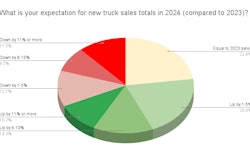
In the intricate process of selling your dealership, Step 2, Information Gathering, holds the key to presenting an opportunity that is not only enticing but thoroughly evaluated.
Providing potential buyers with comprehensive information is essential to empower them in building informed projections and crafting well-grounded offers. This article navigates the critical aspects of information gathering, emphasizing the significance of transparency, organization, and confidentiality in fostering buyer confidence and ensuring a seamless transaction.
As the commercial truck industry continually evolves, the sale of a dealership requires a strategic and well-informed approach. Information gathering, the second step in this journey, emerges as a pivotal phase. By providing potential buyers with a trove of essential data, you not only showcase the value of your dealership but also establish the foundation for a transparent and efficient transaction.
In this article, we will explore the key elements that drive buyer confidence and facilitate the formulation of well-informed offers.
[RELATED: Retirement looming? Step 1 in selling your dealership]
The essence of information gathering:
The essence of information gathering lies in furnishing potential buyers with the necessary tools to assess the opportunity comprehensively. A prospective buyer seeks a detailed understanding of various facets, and providing this information is a strategic move that sets the stage for a mutually beneficial transaction.
1. Financial data: The backbone of evaluation
Transparency in financial data is paramount. Buyers often request a detailed breakdown, including income statements, balance sheets, and cash flow statements. By offering a clear picture of your dealership's financial health, you instill confidence and empower buyers to formulate accurate projections of future earnings.
2. Assets and inventories: Unlocking hidden value
Detailed information on assets and inventories, especially rental and lease fleet details, provides buyers with a comprehensive view of the tangible elements of the deal. This transparency not only facilitates accurate valuation but also enables buyers to identify potential areas for growth and optimization.
[RELATED: Are your finances aligned? Check out our upcoming FET webinar about how to avoid tax liabilities]
3. Real estate: Anchoring the investment
For many dealerships, real estate forms a significant part of the assets. Providing detailed information on your property, including location, size, and any lease agreements, allows buyers to assess the long-term value and potential of the physical space.
4. Manufacturers and sales: Understanding the portfolio
Buyers seek insights into your dealership's relationships with manufacturers, understanding the strength and diversity of the dealership’s portfolio. Detailed information on historical and current sales, including market trends and customer preferences, helps buyers gauge the dealership's market positioning.
5. Contracts to be assumed: Mitigating risks through transparency
Transparency extends to existing contracts that the buyer may need to assume. Clearly outlining contractual obligations, such as service agreements, warranties, or vendor contracts, helps mitigate risks and allows buyers to plan for seamless integration.
[RELATED: Don't let fixation on 'blue sky' lead to storm clouds when selling a business]
6. Your organization: Showcasing operational excellence
Buyers are not just investing in a dealership; they are acquiring an operational framework. Detailed information about your organization's structure, key personnel, and operational processes showcases your commitment to transparency and operational excellence, enhancing buyer confidence.
7. Working with a dealership broker: Confidentiality as a priority
When engaging a dealership broker, the Information Gathering phase is transformed into a meticulous process, culminating in a Confidential Information Memorandum (CIM) or Executive Summary. This document encapsulates all relevant information and is disseminated only after securing a signed Non-Disclosure Agreement (NDA) from the potential buyer.
By structuring information in this way, not only does the dealership maintain control over the dissemination of sensitive data, but it also reinforces the seriousness of the transaction. Confidentiality becomes a cornerstone, and both the seller and the buyer can proceed with the assurance that proprietary information is handled with the utmost care.
In the ever-evolving landscape of dealership mergers and acquisitions, prioritizing the vital aspects of information gathering, with a focus on transparency, organization, and confidentiality, is crucial for establishing yourself as a strategic force in navigating this dynamic terrain.
As you navigate this phase, remember that your commitment to providing well-documented and secure information positions your dealership as a prime opportunity in the eyes of discerning buyers actively evaluating acquisition opportunities.









